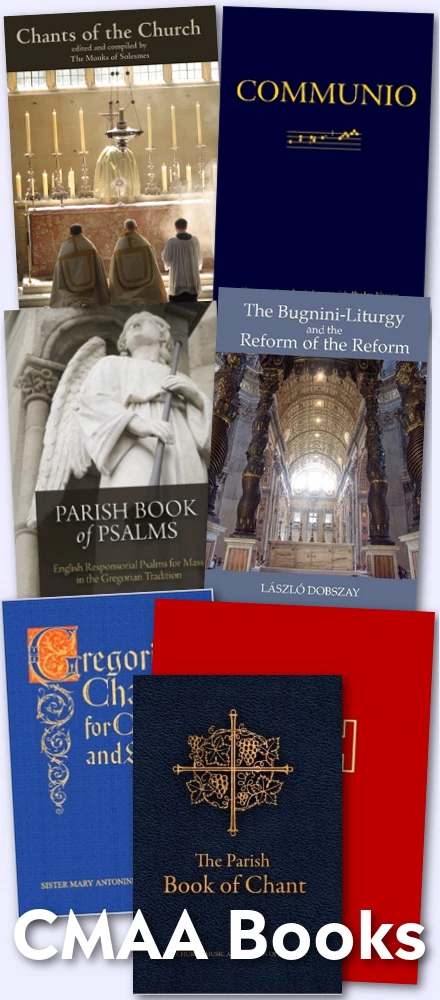The mood among America's liturgical musicians is exuberant today following the Mass for the Pope at St. Patrick's, so it is fitting that tomorrow's introit for the Fifth Sunday in Easter would set the famous text: Sing to the Lord a new song, alleluia; for the Lord has accomplished wondrous deeds, alleluia; he has revealed his justice in the sight of the Gentiles, alleluia.
What struck me about this melody, the first time I heard it, is not so much its happy mood, which you might expect from the text, but its serenity and calm, its steadiness and orderliness. The same lifting figure emerges three times, but mostly the chant allows the "new song" to cover only a small range, very comfortable for both the voice and the ear.
With all the talk recently of music appropriate to the new liturgy, there has been the usual debate about old vs. new. We can see from this chant that there is a sense in which the debate is fruitless. What is need is not dated music, whether or or new, but timeless music, which is ever renewed in liturgy.
The communio of the day, meanwhile, offers a completely different musical sense. It is deeply mysterious, as it should be, because it is tell the story of Christ's presence after rising from the dead. "Have I been so long a time with you and have you not known me? Philip, he that seeth me seeth the Father also: do you not believe that I am in the Father and the Father in me?"
What need should there be for looking for exotica in strange places when we have such challenging and interesting music given to us by the Church? Again, this piece is neither old sounding or new sounding but eternal in the manner in which it touches our hearts, teaching us and inspiring us.
Saturday, April 19, 2008
Sing to the Lord a New Song
UnknownMore recent articles:
The Easter Sequence Laudes SalvatoriGregory DiPippo
The traditional sequence for Easter, Victimae Paschali laudes, is rightly regarded as one of the greatest gems of medieval liturgical poetry, such that it was even accepted by the Missal of the Roman Curia, which had only four sequences, a tradition which passed into the Missal of St Pius V. But of course, sequences as a liturgical genre were extre...
The Paschal Stichera of the Byzantine Rite in EnglishGregory DiPippo
One of the most magnificent features of the Byzantine Rite is a group of hymns known as the Paschal stichera. These are sung at Orthros and Vespers each day of Bright Week, as the Easter octave is called, and thenceforth on the Sundays of the Easter season, and on the Leave-taking of Easter, the day before the Ascension. As with all things Byzantin...
Medieval Vespers of EasterGregory DiPippo
In the Breviary of St Pius V, Vespers of Easter Sunday and the days within the octave present only one peculiarity, namely, that the Chapter and Hymn are replaced by the words of Psalm 117, “Haec dies quam fecit Dominus; exsultemus et laetemur in ea. – This is the day that the Lord has made; let us be glad and rejoice therein.” In the Office, this...
Summer Graduate-Level Sacred Music Study - Tuition-freeJennifer Donelson-Nowicka
The May 1st application deadline is approaching for summer graduate courses in sacred music at the Catholic Institute of Sacred Music. Graduate-level study structured for busy schedulesIn-person, intensive course formatsAffordable room & boardFree tuitionLearn more and apply here.Courses:Choral InstituteComposition SeminarOrgan ImprovisationIn...
The Last Service of EasterGregory DiPippo
Following up on Monday’s post about the service known as the Paschal Hour in Byzantine Rite, here is the text of another special rite, which is done after Vespers on Easter day itself. It is brief enough to show the whole of it with just one photograph from the Pentecostarion, the service book which contains all the proper texts of the Easter seaso...
Should Communion Sometimes Be Eliminated to Avoid Sacrilege?Peter Kwasniewski
In a post at his Substack entitled “Nobody is talking about this in the Catholic world,” Patrick Giroux has the courage and good sense to raise the issue of the indiscriminate reception of the Lord at weddings and funerals where many attendees are not Catholics, or, if Catholics, not practicing, not in accord with Church teaching, or not in a state...
Update on the Palestrina500 Festival in Grand RapidsPeter Kwasniewski
On Friday, February 14th, the feast of Saint Valentine, Sacred Heart of Jesus Parish in Grand Rapids, MI welcomed Gesualdo Six from London to sing a choral meditation and Mass for the parish's yearlong Palestrina500 festival.The choral meditation consisted of:Palestrina: Litaniae de Beata Virgine Maria a6Antoine Brumel: Sub tuum praesidiumJosquin d...
Catholic Education Foundation Seminar 2025: The Role of the Priest in Today’s Catholic SchoolDavid Clayton
July 16-18, at the Athenaeum of Ohio (the seminary of the Archdiocese of Cincinnati).Fr Peter Stravinskas of the Catholic Education Foundation is once again offering this excellent three-day seminar, intended primarily for bishops, priests, and seminarians. It is entitled The Role of the Priest in Today’s Catholic School.For further information: c...
Pope Francis RIPGregory DiPippo
Deus, qui inter summos sacerdótes fámulum tuum Franciscum ineffábili tua dispositióne connumerári voluisti: praesta, quáesumus; ut, qui Unigéniti Filii tui vices in terris gerébat, sanctórum tuórum Pontíficum consortio perpétuo aggregétur. Per eundem Christum, Dóminum nostrum. Amen.Courtesy of Shawn Tribe and Liturgical Arts JournalGod, Who in Thy ...
The Byzantine Paschal HourGregory DiPippo
In the Roman Rite, the minor Hours of Easter and its octave are celebrated according to a very simple and archaic form, which consists solely of the psalmody, the antiphon Haec dies, and the prayer, with the usual introduction and conclusion. (Haec dies is labeled as an “antiphon” in the Breviary, but it is identical to the first part of the gradu...




















